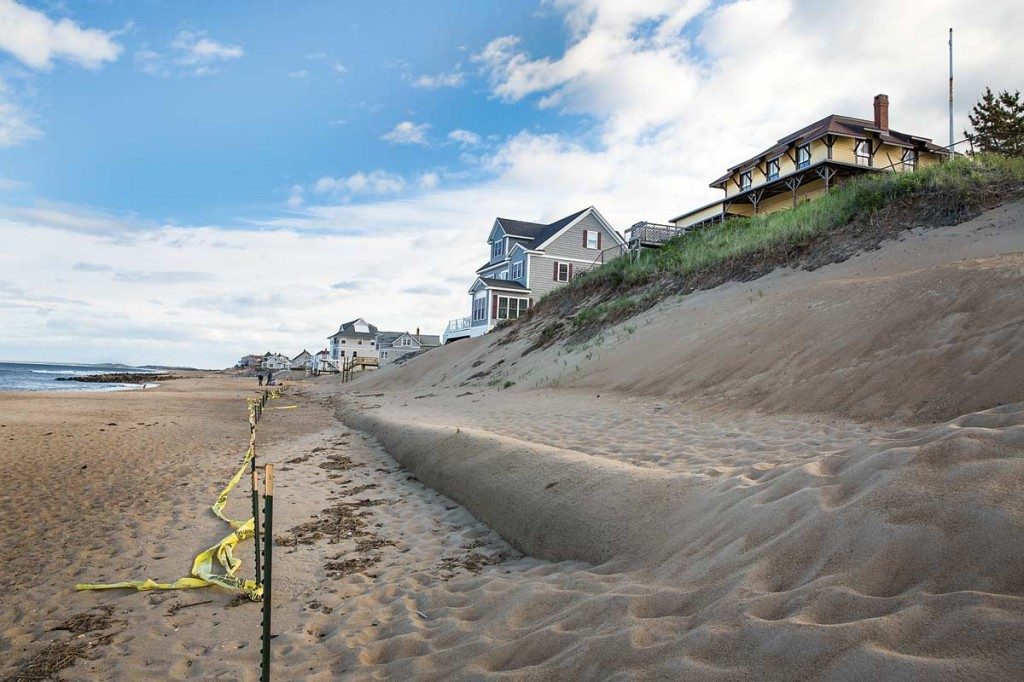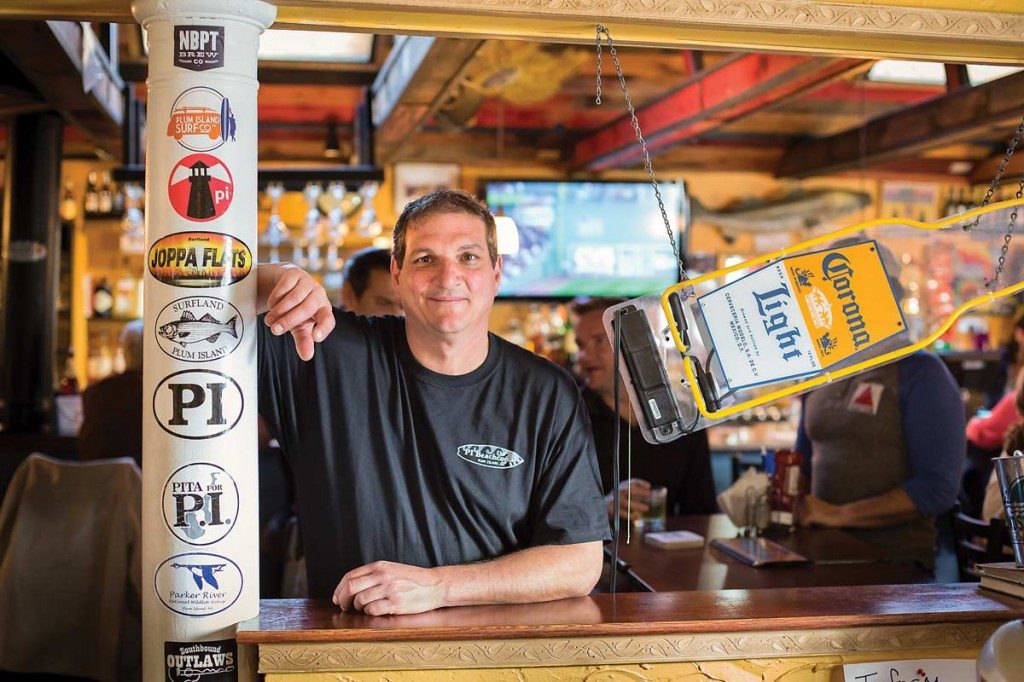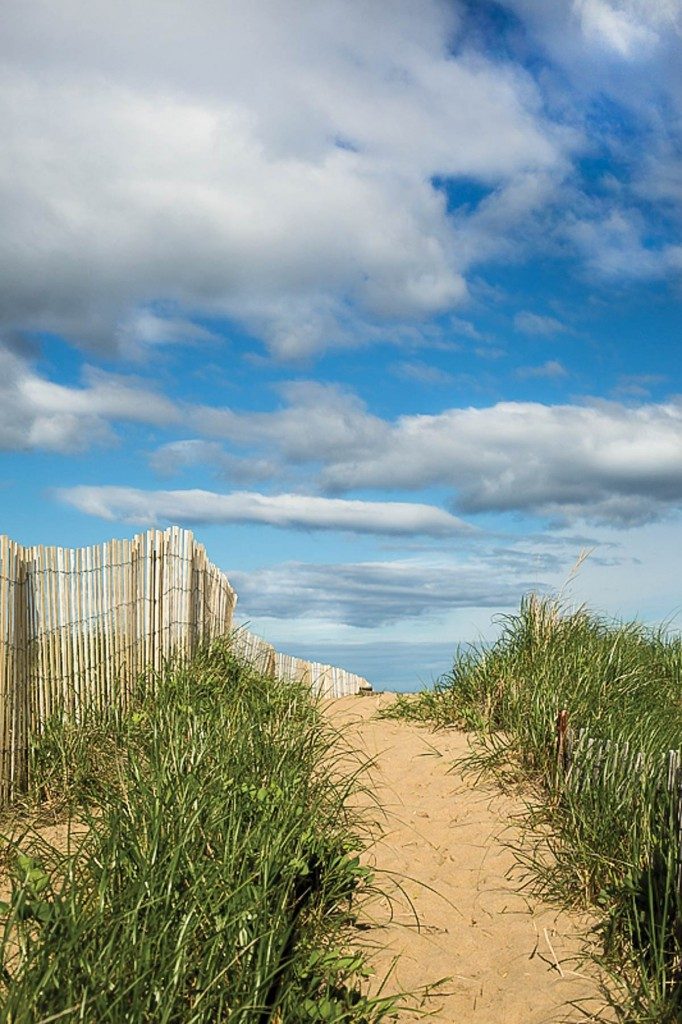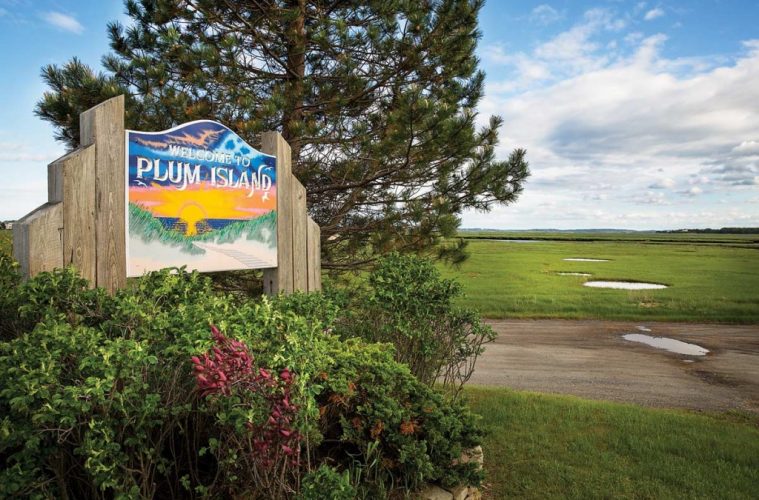Facing a perpetual cycle of destruction at the hands of Mother Nature, Plum Islanders grapple with keeping their beloved island alive.
Each winter, Dan Mahoney spends a few weeks in Puerto Rico to get away from the brutal weather that descends upon Plum Island. But this past March, even when 1,000 miles away, he couldn’t escape it. As waves and wind pounded Plum Island’s shoreline for several days, national news broadcasts featured images of his neighbors’ homes toppling over the dune, their personal possessions washing away like driftwood in the surf.
Wearing a Plum Island T-shirt for much of his vacation, Mahoney says many people who were familiar with the destination were less than sympathetic, wondering why anyone would build a home in such a vulnerable place. “It’s tough enough being away, seeing every bar with a TV showing Plum Island, with people you know having their homes fall in the ocean,” Mahoney says. “Then, to have people saying to you, ‘You deserve what happened to you. You don’t belong out there.’ I finally snapped.”

Bulldozers push the sand to create larger dunes.
The winter of 2013 is one Plum Islanders won’t soon forget, and how they are adapting to these changing elements will likely decide the fate of many more homes. Sea-level rise and climate change are posing increased threats to our shorelines up and down the East Coast, not to mention the amorphous barrier island made of sand that is Plum Island. By the time this winter’s weather finally gave way, two homes were lost to the ocean, and four more had to be demolished to prevent their remains from washing out to sea. Still another six were rendered temporarily uninhabitable, and several dozen more were damaged. But if there were locals thinking “I told you so,” they kept it to themselves as homeowners and contractors sifted through the rubble.
Bill Sargent, an Ipswich resident who started the Coastlines Project at Woods Hole in 1985 and has written several books about sea-level rise, visited the island during the March storms. “It was the most terrifying moment I’ve ever had on a barrier beach,” he says. “Those waves were just pounding in; houses were toppling off the edge of the beach. There was danger [that] the whole island could have broken in two. If that happens—when it happens—it will sever the water and sewer mains, and you will have hundreds of homes isolated.”
Graham McKay, who was renting a beachfront cottage for the winter with his girlfriend, had to cut the home’s deck off with a chainsaw one night to keep it from pulling the rest of the house over the dune. As a neighbor whose house was leaning over the dune helped McKay move belongings out, he watched his own bed slide into the ocean.
Kyree Gerson, co-owner of Mad Martha’s Island Cafe, located on a part of the island that saw dunes actually grow four feet over the winter, consoled another homeowner as he sat and waited for his home’s inevitable fate. At the same time, curious visitors flocked to bear witness to the ongoing disaster, and the media was calling relentlessly, looking for victims to interview.
“It broke my heart, actually,” Gerson says. “We were the first public access open, and we literally had customers complaining that they couldn’t see the homes falling in.”
but when the summer sun is shining, there’s no telling the inhabitants of Plum Island’s 1,200 homes that they don’t belong there. They’ll tell you there’s no place they’d rather be, and it’s easy to see why.
On a nice day, tourists or locals can take the scenic two-mile drive down Plum Island Boulevard and start with French toast at Mad Martha’s. After breakfast, they can lounge on a beautiful, uncrowded beach, then enjoy some ribs at the Beachcoma for lunch. They can explore a nature trail on the wildlife refuge in the afternoon, and perhaps top it off with a plate of fresh fish and a glass of wine at Plum Island Grille.

Gregg Pugh, Owner, Beachcoma, Plum Island
While the Grille has been a mainstay for both Plum Islanders and Newburyporters, there is a renewed energy inside the Beachcoma and Mad Martha’s—a sign that Plum Island’s culture isn’t being handed over to its wealthy newcomers just yet. On any given morning in front of Mad Martha’s, you’ll find “an Audi parked next to a beat-up Corolla,” Gerson says. For the past two years, Gerson and co-owner Kendall Bowie have served breakfast and lunch daily, and during the summer, BYOB dinners every Thursday night. Two large tables in the middle of the restaurant create some unlikely friendships.
“I think there’s that old Plum Island crew that sticks to itself, but especially here, you’re forced to sit with strangers,” Gerson says. “We say all the time, ‘You would never have pegged those two to start talking to each other.’”
Gregg Pugh, a former owner of Mad Martha’s, opened the Beachcoma in 2011 as an homage to and replacement for the old Atty May’s Beachcomber, which was for many years a local haunt. Pugh, who has lived on Plum Island for 15 years, bought the building from the Geiger family, who own the posh island hotel blue, The Inn at the Beach, just around the corner. The late Jeanne Geiger, whose husband was former Aeropostale CEO Julian Geiger, arrived with visions of turning the island into a Manhattan retreat less than a decade ago. After she died in 2008, that vision faded, though blue still has a steady clientele paying rates of $500 to $1,200 per night.
“I wanted [Beachcoma] to be family friendly,” Pugh says, “somewhere to just hang out at a beach bar.” Rather than becoming the Blue Penguin nightclub as the Geigers had planned, the Beachcoma is a cozy bar for the local firemen, carpenters, and visitors who come to dance to live music on summer Sundays.
“[Jeanne Geiger] had good intentions,” Pugh says, “but maybe she didn’t know what the island needed.” On a wall of the bar, a painted message reads, “It’s the characters of Plum Island that give Plum Island its character.” Those characters showed that character this spring. Putting aside any resentment over gentrification, they raised money for homeowners who, in many cases, had deeper pockets than their own. Pugh held two benefits, including a pig roast, and collected more than $11,000 for sand bags and other preventive measures.
On plum island, everyone has his or her own take on oceanography. The longtime locals will remind you that this cycle of destruction on the island has happened before. Scientists will tell you the modern-day threats are getting worse. The newcomers believe that with some money, smarts, and hard work, the effects of erosion can be slowed, or even halted.
Most agree that the erosion goes in 25- to 30-year year cycles, with the last episode coming in the late 1970s, when several homes were lost. But back then, the lost structures were summer cottages worth thousands of dollars, not year-round homes worth as much as $800,000.
“When people come look in the spring or summertime, it looks fine; they build, then something happens,” says Ron Barrett, who has lived on the island since the 1950s and is president of the Plum Island Taxpayers Association, a group that has advocated for Islanders since 1948. “It’s kind of crazy.
People have a short memory. But we haven’t really lost a house since the early ’80s. People who have houses now weren’t here [then].”
Marc Sarkady, a successful business consultant, first moved to the island in the late 1980s, and later built a million-dollar house just north of the beach center that is now steadily being encroached upon by the ocean. In 2006, he and some neighbors started the Plum Island Foundation, a group that works with state regulators to allow man-made protections for property and the island’s infrastructure.
The Taxpayers Association and the Foundation may in some ways represent the old and new on the island, but the increasing threats have created a common goal. Maybe a few of the locals even gained an appreciation for their wealthy neighbors, who have had a string of recent successes in winning back property rights for homeowners. For years, state and federal regulators wanted to “protect the environment at all costs,” Sarkady says, but now the crumbling jetties that many blame for fueling the rate of erosion are being fixed, while sand mining is restoring the beachfront, and bulldozers, sandbags, and boulders are allowed to protect the beachfront homes.
“Many people here think of people like myself as newcomers, but I think there’s been a kind of melding together,” Sarkady says. “Plum Island is a place where people find a great deal of joy and connection. We’re working to help that go forward and be possible. We’ve also pulled together people working at the local, state, and federal levels in a way that really is democracy in action, where people are really working together to make it happen.”
The fixes appear to be working—for now. Where there was once no beach left in front of many homes, there is now 20 feet or more of sand, thanks to the work of bulldozers and contractors. However, science tells us these fixes will be temporary.

Plum Island
Mike Morris, who first started studying the island’s currents for surf reports, took the advice of an old teacher and bought a house on the island back from the shore near an old tree. If the tree had stood the test of time, it was a sign the biggest storms hadn’t reached that far.
As part of an extensive study he’s conducted over many years, Morris has used aerial photos provided by Barrett to draw a line tracing the edge of vegetation along the dune, which he says serves as a high-water mark. That line goes through, and even behind, many of the beachfront homes.
“Anything built in front of the high water mark, the ocean will take away,” Morris says. Though he thinks this cycle of erosion may be waning, efforts like beach scraping, sandbags, and boulders to stem the tide “are just bad ideas,” he believes.
Sargent believes the cycle of building and rebuilding on these fragile dunes is a hopeless endeavor, as the entire mass of sand continues to slowly migrate toward the mainland, one wave, wind gust, and storm at a time. Climate change and sea-level rise are only serving to speed up the process. “[Sea-level rise] is why barrier beaches are moving landward,” Sargent says. “We see it during major storms, but it’s happening every day in much smaller ways.”
Sargent favors a FEMA program that reimburses homeowners to take down their homes in vulnerable areas, creating a scenic vista instead of a disaster waiting to happen. But demand for homes on the island, says local real estate agent Dolores Person, is still hot. The activity has just moved south, where the beach is more stable—for now.
As winter creeps closer, Joslin will distribute written guidelines to island homeowners, warning them of the dangers and how to prepare, as he does every year. The worst part of his job, he says, is telling someone they can’t go back in their home, and he questions whether homes belong on the edge of a sand bar that is slowly washing away. The lure of the island, it seems, is too much to resist.
In June, the state Department of Environmental Protection agreed to let those who lost homes in March to rebuild on the same spot, but not everyone agrees that this a good move. “People either aren’t listening or aren’t paying attention,” Joslin says. “The erosion is nothing new, and it’s not likely to go away.”

